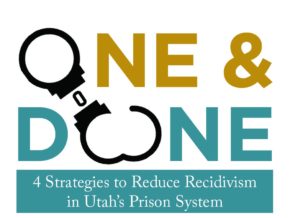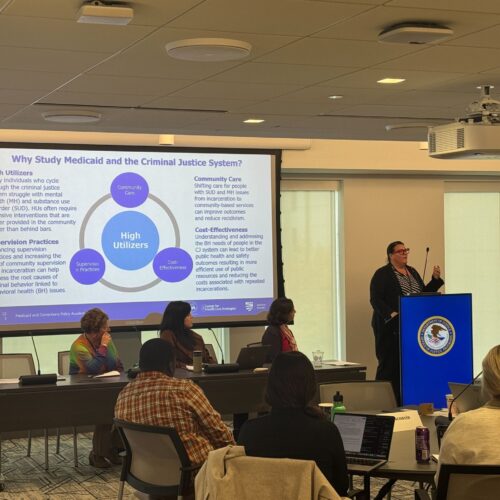 In January 2014, the Utah Association of Counties invited national experts to lead a training event on recidivism reduction for its members. Council of State Governments Justice Center (CSG Justice Center) Director Michael Thompson and Jake Horowitz of The Pew Charitable Trusts’ Public Safety Performance Project presented on national research on and trends in recidivism reduction, tracking recidivism rates, and the role of community-based behavioral health care services in reducing recidivism. The daylong event, entitled “One and Done: Four Strategies to Reduce Recidivism in Utah’s Prison System,” brought together more than 60 representatives from Utah’s county and state governments to discuss issues related to recidivism.
In January 2014, the Utah Association of Counties invited national experts to lead a training event on recidivism reduction for its members. Council of State Governments Justice Center (CSG Justice Center) Director Michael Thompson and Jake Horowitz of The Pew Charitable Trusts’ Public Safety Performance Project presented on national research on and trends in recidivism reduction, tracking recidivism rates, and the role of community-based behavioral health care services in reducing recidivism. The daylong event, entitled “One and Done: Four Strategies to Reduce Recidivism in Utah’s Prison System,” brought together more than 60 representatives from Utah’s county and state governments to discuss issues related to recidivism.
The event offered an opportunity for criminal justice policymakers from around the state to connect and share insights about challenges facing counties in Utah. Policymakers also discussed potential strategies to address these challenges at the state level using the bi-partisan, data-driven justice reinvestment approach, as well as employing a targeted, county-level research-based effort.
“This meeting was a wonderful opportunity to help our members learn more about the latest research and science on recidivism reduction and apply it to existing policies and practices in Utah’s counties and within our state agencies,” said Brent Gardner, Executive Director of the Utah Association of Counties. “When I learned about the National Reentry Resource Center (NRRC) through a meeting organized by NACo (the National Association of Counties), I thought it would be a great resource to bring home to Utah.” Supported by the U.S. Department of Justice’s Bureau of Justice Assistance under the Second Chance Act, the NRRC provides education, training, and technical assistance to public agencies and nonprofit organizations working on prisoner reentry.
NACo is working with the CSG Justice Center, which manages the NRRC, to help connect the country’s more than 3,000 counties to the center’s resources. “We are excited by the possibility of working with the National Reentry Resource Center and state associations of counties to bring these national resources to local governments around the country,” said Matthew D. Chase, Executive Director of NACo. “We know a number of counties have already worked closely with the CSG Justice Center to analyze data to improve local criminal justice policy and hope to build on that momentum with additional sites.”
“This event brought state and local policymakers and practitioners together to learn about research and practices that are relevant to all of us,” said Susan Burke, Director of the Utah Division of Juvenile Justice Services and a CSG Justice Center board member. “It lays a strong foundation for future discussions and trainings on other topics of mutual interest.”
“It was an incredibly informative discussion that focused on how to bring promising programs and policies together into systematic approaches that can be implemented at the county-level,” said Chief Pamela Lofgreen, Jail Commander of the Salt Lake County Sheriff’s Office. “Based on the discussions we had, it is clear that this event has energized the ongoing conversation for many Utah state and county leaders about how best to reduce recidivism and improve criminal justice practices.”
When returning to their communities from criminal justice settings, people with behavioral health needs face barriers in accessing…
Read MoreNew Hampshire Department of Corrections Commissioner Helen Hanks presents at the Medicaid and Corrections Policy Academy in-person meeting.
Read More Assigned to the Cloud Crew: The National Incarceration Association’s Hybrid Case Management for People with Behavioral Health Needs
Assigned to the Cloud Crew: The National Incarceration Association’s Hybrid Case Management for People with Behavioral Health Needs
When returning to their communities from criminal justice settings, people with behavioral health needs face barriers in accessing basic needs—including food, housing, employment, transportation, education, clothing, and substance use and mental health services—which increases their risk of experiencing a crisis.
Read More Meet the Medicaid and Corrections Policy Academy Mentor States
Meet the Medicaid and Corrections Policy Academy Mentor States
New Hampshire Department of Corrections Commissioner Helen Hanks presents at the Medicaid and Corrections Policy Academy in-person meeting.
Read More Six States Commit to Improving Statewide Strategies to Address Youth Crime, Violence and Behavioral Health
Six States Commit to Improving Statewide Strategies to Address Youth Crime, Violence and Behavioral Health
The Council of State Governments (CSG) Justice Center has launched the Collaborating for Youth and Public Safety Initiative (CYPSI) in partnership with six states: California, New Mexico, New York, Ohio, Oklahoma, and Rhode Island. The initiative will help states develop, fund, and effectively implement a research-based service continuum to improve public safety and behavioral health, education, and other outcomes for youth.
Read More Bipartisan Group of 88 Lawmakers Push for Continued Funding for Reentry and Recidivism Programs
Bipartisan Group of 88 Lawmakers Push for Continued Funding for Reentry and Recidivism Programs
A bipartisan group of 88 lawmakers, led by Representatives Carol Miller (R-WV) and Danny Davis (D-IL), wrote a letter calling for continued funding for the Second Chance Act in the Fiscal Year 2026 Commerce, Justice, Science, and Related Agencies appropriations bill.
Read More










